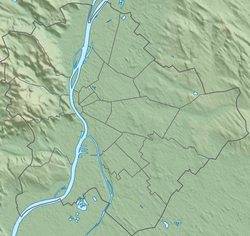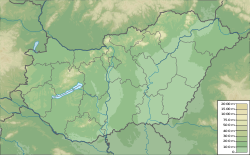Heroes' Square (Budapest)
This article needs additional citations for verification. (June 2013) |
Andrássy Avenue and the Underground" part of Budapest, including the Banks of the Danube, the Buda Castle Quarter and Andrássy Avenue | |
|---|---|
| Criteria | Cultural: (ii)(iv) |
| Reference | 400bis-002 |
| Inscription | 1987 (11th Session) |
| Extensions | 2002 |
| Coordinates | 47°30′54″N 19°4′40″E / 47.51500°N 19.07778°E |
Hősök tere (Hungarian: [ˈhøːʃøk ˈtɛrɛ]; lit. 'Heroes' Square') is one of the major squares in Budapest, Hungary, noted for its iconic Millennium Monument with statues featuring the Seven chieftains of the Magyars and other important Hungarian national leaders, as well as the Memorial Stone of Heroes, often erroneously referred as the Tomb of the Unknown Soldier. The square lies at the outbound end of Andrássy Avenue next to City Park (Városliget). It hosts the Museum of Fine Arts and the Palace of Art (Műcsarnok). The square has played an important part in contemporary Hungarian history and has been a host to many political events, such as the reburial of Imre Nagy in 1989. Most sculptures were made by sculptor György Zala from Lendava, with one made by György Vastagh.
In Budapest there are three more squares named Hősök tere, 'Heroes' Square', in the districts or neighbourhoods of Soroksár, Békásmegyer and Rákosliget.
History and outlook
Hősök tere is surrounded by two important buildings,
The central feature of Heroes' Square, as well as a landmark of Budapest, is the Millennium Memorial (
When the monument was originally constructed, Hungary was a part of the
On 16 June 1989 a crowd of 250,000 gathered at the square for the historic reburial of Imre Nagy, who had been executed in June 1958.

At the front of the monument is the Memorial Stone of Heroes (Hősök emlékköve), a large stone cenotaph surrounded by an ornamental iron chain. The cenotaph is dedicated "To the memory of the heroes who gave their lives for the freedom of our people and our national independence." While some guide books refer to this as a tomb it is not a burial place but is erroneously referred as the "Tomb of the Unknown Soldier". Hungary has no Tomb of the Unknown Soldier unlike most European countries, nor any memorial to the unknown fallen of wars. No human remnants are interred here, there is only an artesian well under the tombstone-like memorial. The Memorial Stone of Heroes was originally erected in 1929 as a tribute to those who died defending Hungary's 1000-year-old borders. It was removed in 1951 as its message was politically unacceptable for the Communist regime. The current one was built at the same spot in 1956. The memorial is surrounded by a fence and it is off limits for visitors. The Ministry of Defence only opens the gate for foreign dignitaries and official state ceremonies.
Behind the cenotaph but within the decorative chain is a flat bronze plate which marks the site of an artesian well whose drilling was completed in 1878 by Vilmos Zsigmondy. This well provides water for the Széchenyi thermal bath behind the monument and the Dagály Baths in the Népfürdő utca. The well reached a depth of 971 meters and produces 831 liters of hot water per minute at 74 degrees Celsius.
The Heroes' Square monument has a 90% duplicate in Shanghai Global Paradise, Shanghai. Since its opening in 1996, it has been mostly degraded and most statues removed.
Millennium Monument
The back of the monument consists of two matched colonnades, each with seven statues representing great figures of Hungarian history.
This is a list of the statesmen portrayed in the semi-circular arcades, with the topic of the relief below each figure given below the name.
Statues of the column
-
The column
-
The top of the column depictsArchangel Gabriel, who holds the Hungarian Holy Crownand the apostolic double cross in his hands
-
Left side view of some of the statues of the Seven chieftains of the Magyars
Directly behind the cenotaph is a column topped by a statue of the archangel Gabriel. In his right hand the angel holds the Holy Crown of St. Stephen (Istvan), the first king of Hungary. In his left hand the angel holds a two-barred apostolic cross, a symbol awarded to St. Stephen by the Pope in recognition of his efforts to convert Hungary to Christianity. In Hungarian it is referred to as the double cross or the apostolic double cross.
At the base of the column is a group of seven mounted figures representing the
Statues of the left colonnade
Topping the outer (left) edge of the left colonnade is a statue of a man with a scythe and a woman sowing seed, representing Labour and Wealth. At the inner (right) end of the left colonnade, is a male figure driving a chariot using a snake as a whip and representing War. For the initial five statues of Habsburg emperors and the corresponding reliefs, see above in the history paragraph.
-
Labour and Wealth (on the left colonnade)
-
Charioteer with a snake, symbolising War
-
Stephen I of Hungary; the king receives the crown from an emissary of the Pope
-
Ladislaus I of Hungary; the king slays the Cuman abductor
-
Coloman of Hungary; the king prohibits the burning of witches
-
Béla IV of Hungary; the king rebuilds the country after the Mongol invasion
-
battle of Marchfeld[dubious]
-
Louis I of Hungary; King Louis the Great occupies Naples
Statues of the right colonnade
At the inner (right) end of the right colonnade is a female figure in a chariot holding a palm frond representing Peace. At the outer (left) end of the right colonnade is a double statue of a man holding a small golden statue and a woman with a palm frond, representing Knowledge and Glory.
-
The female statue of Peace
-
Knowledge and Glory
-
Matthias Corvinus; the king with his scholars
-
István Bocskay; Hajdúsoldiers defeat the Habsburg imperial forces
-
Gabriel Bethlen (statue by György Vastagh); the prince concludes a treaty with Bohemia
-
Imre Thököly; the battle of Szikszó
-
Francis II Rákóczi; the prince returns from Poland
-
Lajos Kossuth; Kossuth rallies the peasants of the Great Plain
Gallery
Millennium Monument
-
Heroes' Square at night
-
Aerial
Buildings around the square
-
Kunsthalle Budapestat the right side of the Millennium Monument
-
Kunsthalle, The main Entrance
-
Museum of Fine Arts at the left side of the Millennium Monument
-
Museum of Fine arts: The main entrance
-
Behind the Millennium Monument: copy of the Gothic Vajdahunyad Castle
References
- Hajós, György, Heroes' Square, Municipality of Budapest (2001)
- Gerő, András, Heroes' Square Budapest, Corvina (1990)
- ^ "Early Development of Community Transport (1800-1968)". www.bkv.hu.













![Charles I of Hungary; King Ladislaus IV defeats Ottokar at the battle of Marchfeld[dubious – discuss]](http://upload.wikimedia.org/wikipedia/commons/thumb/2/23/Budapest_Heroes_square_K%C3%A1roly_Robert.jpg/80px-Budapest_Heroes_square_K%C3%A1roly_Robert.jpg)

















